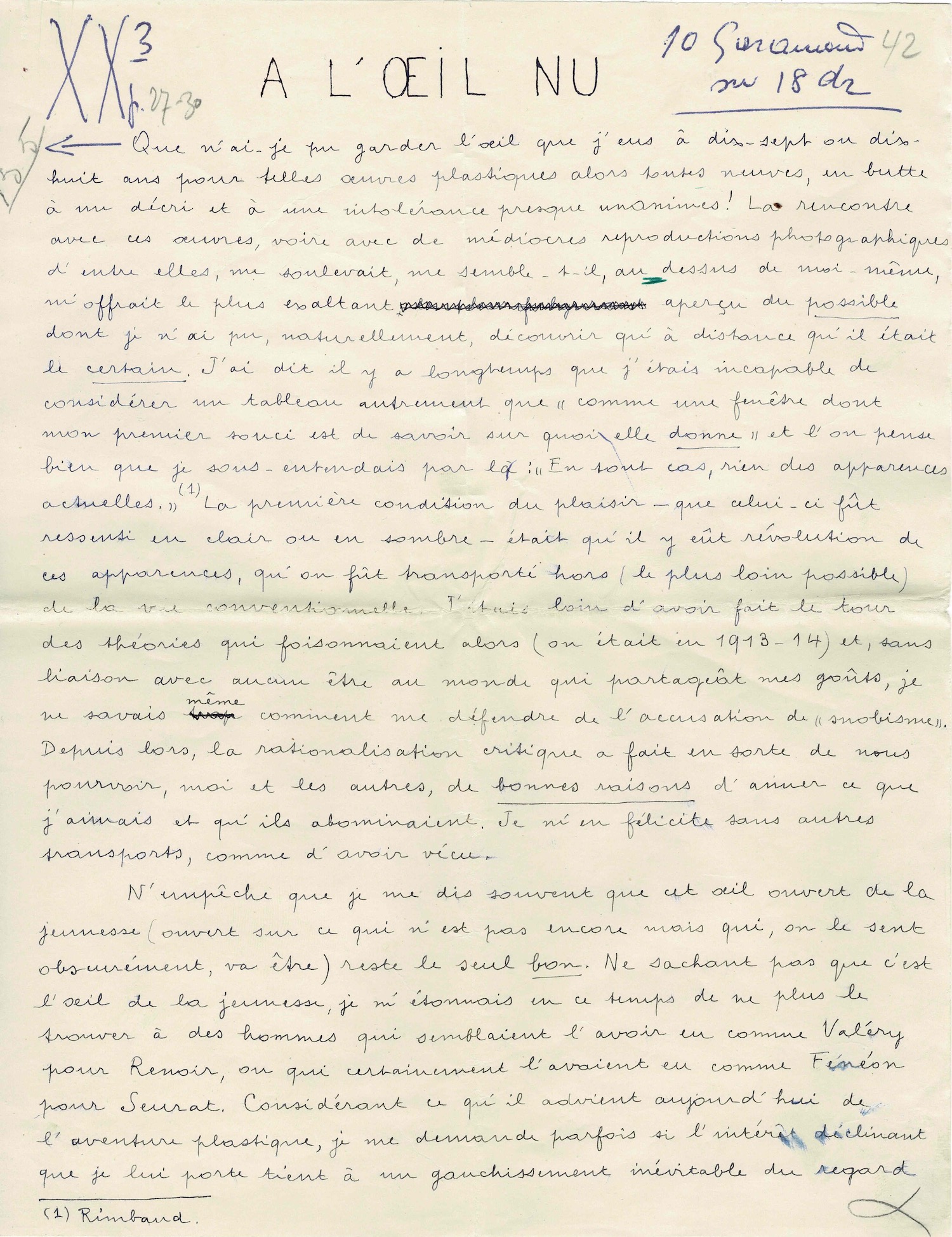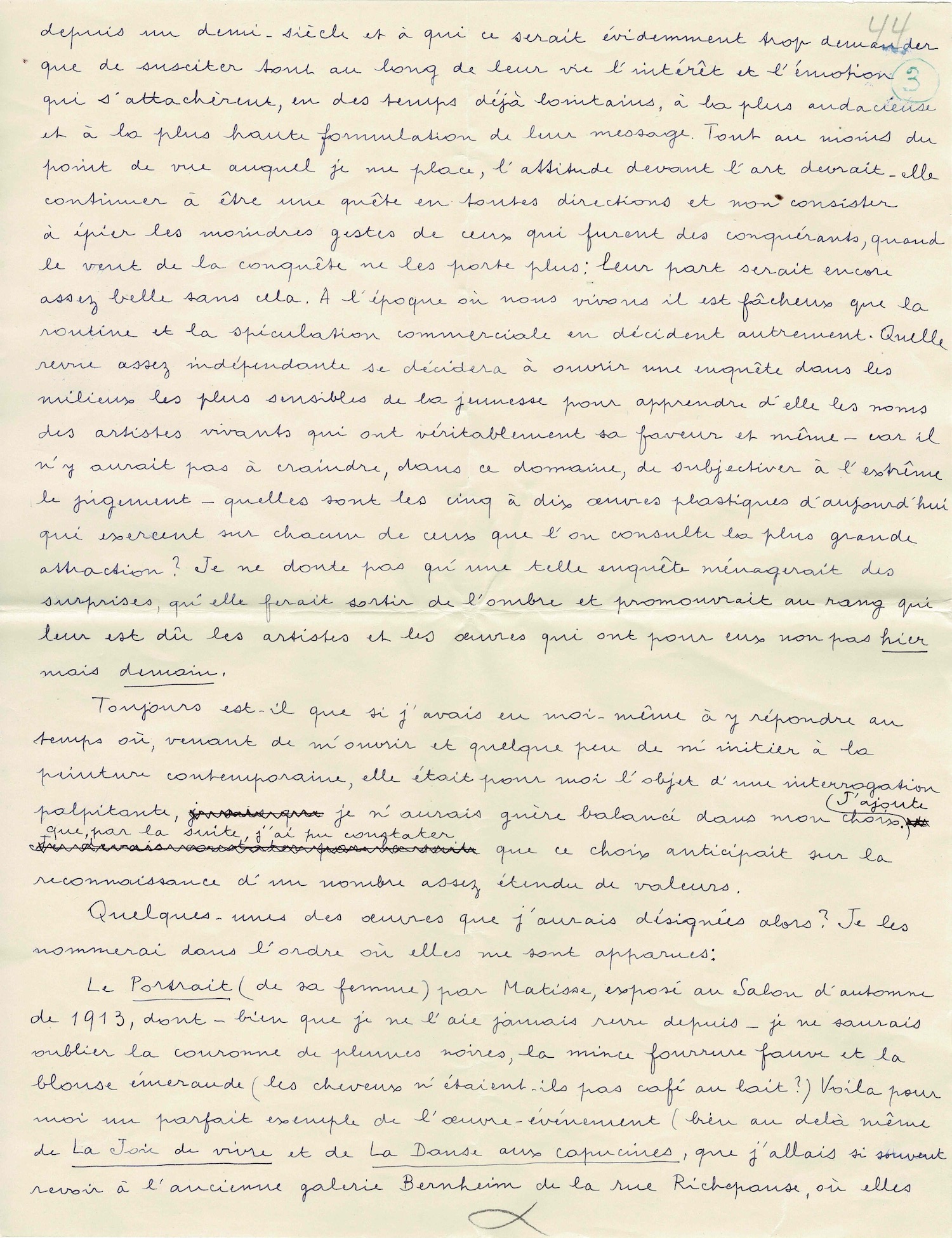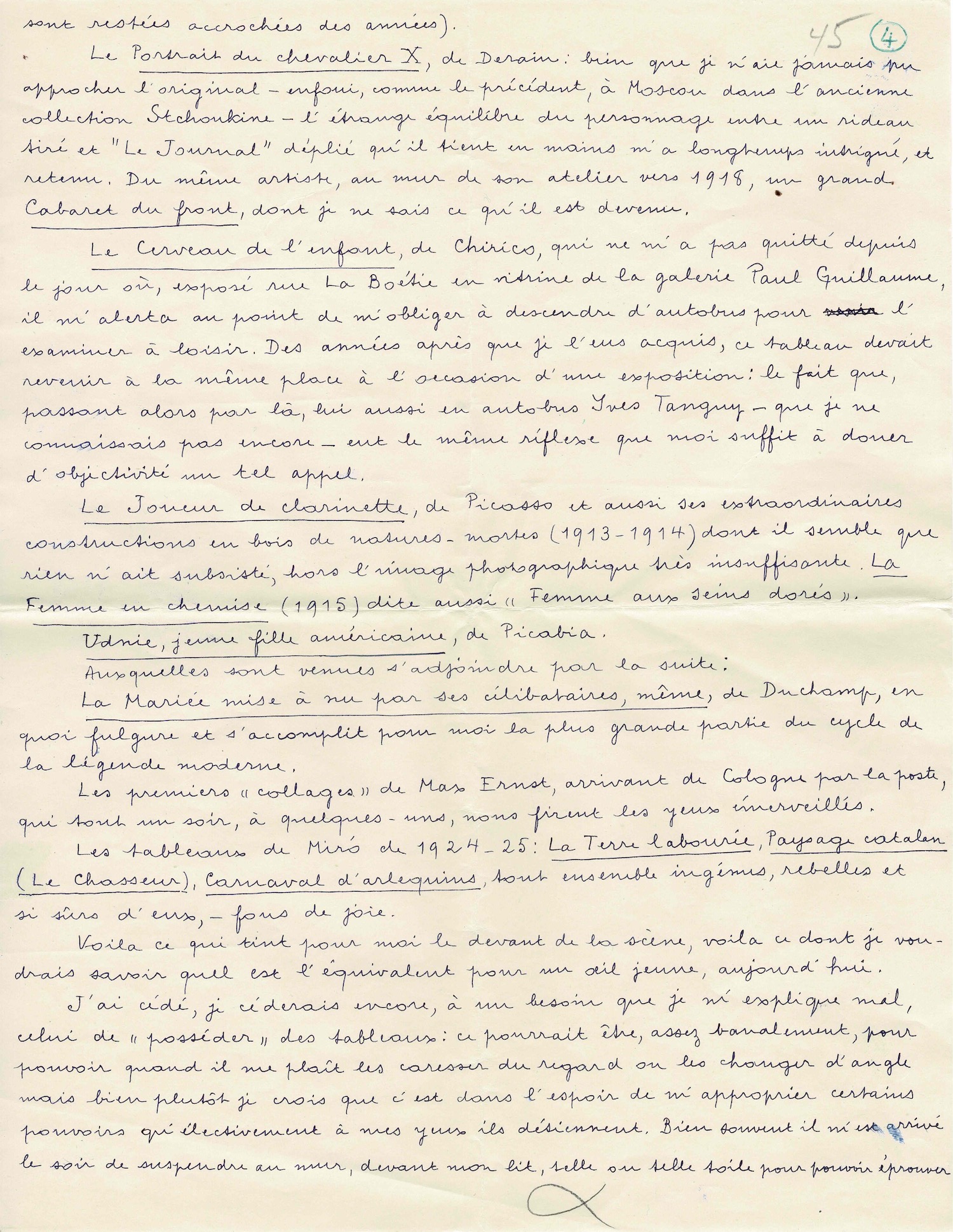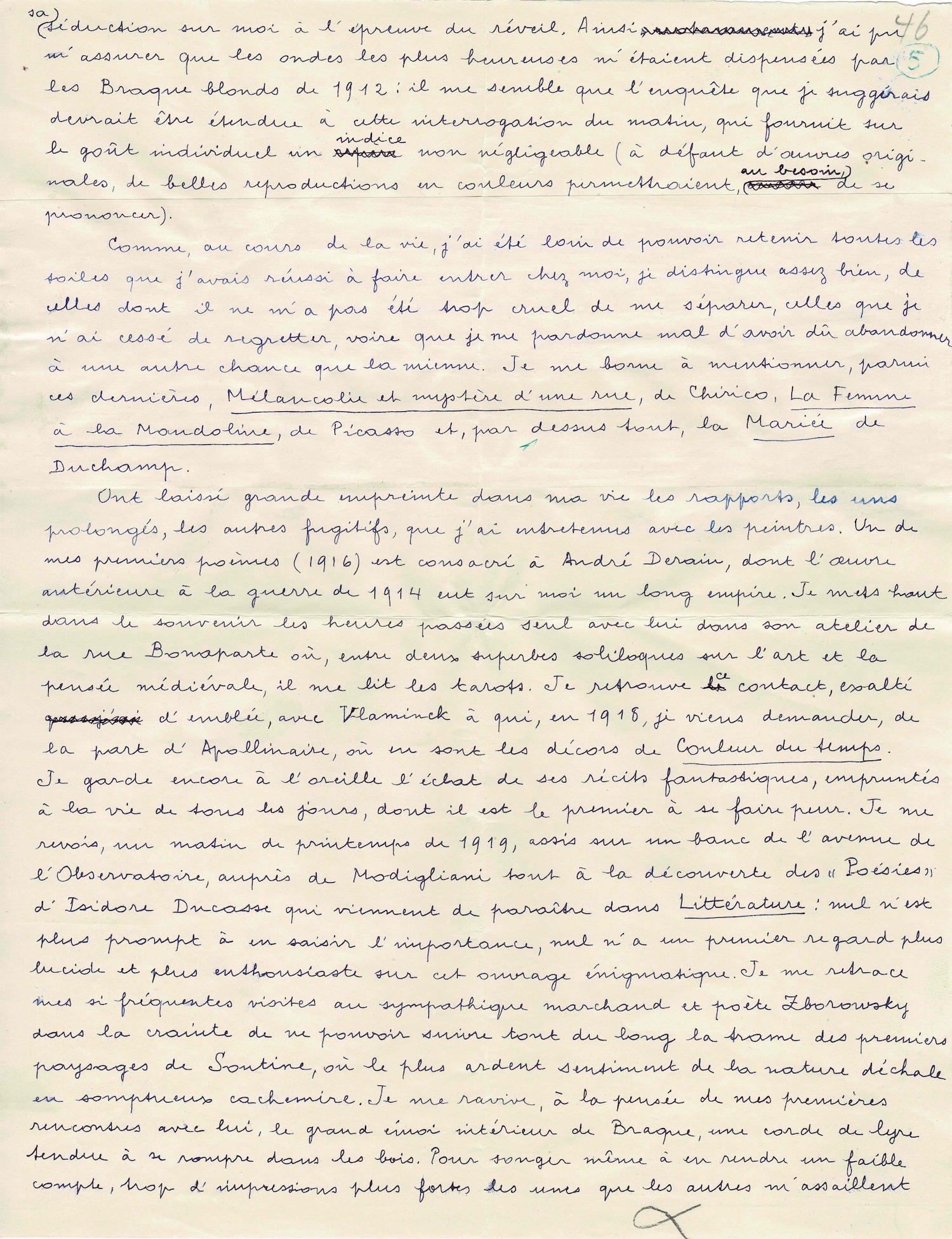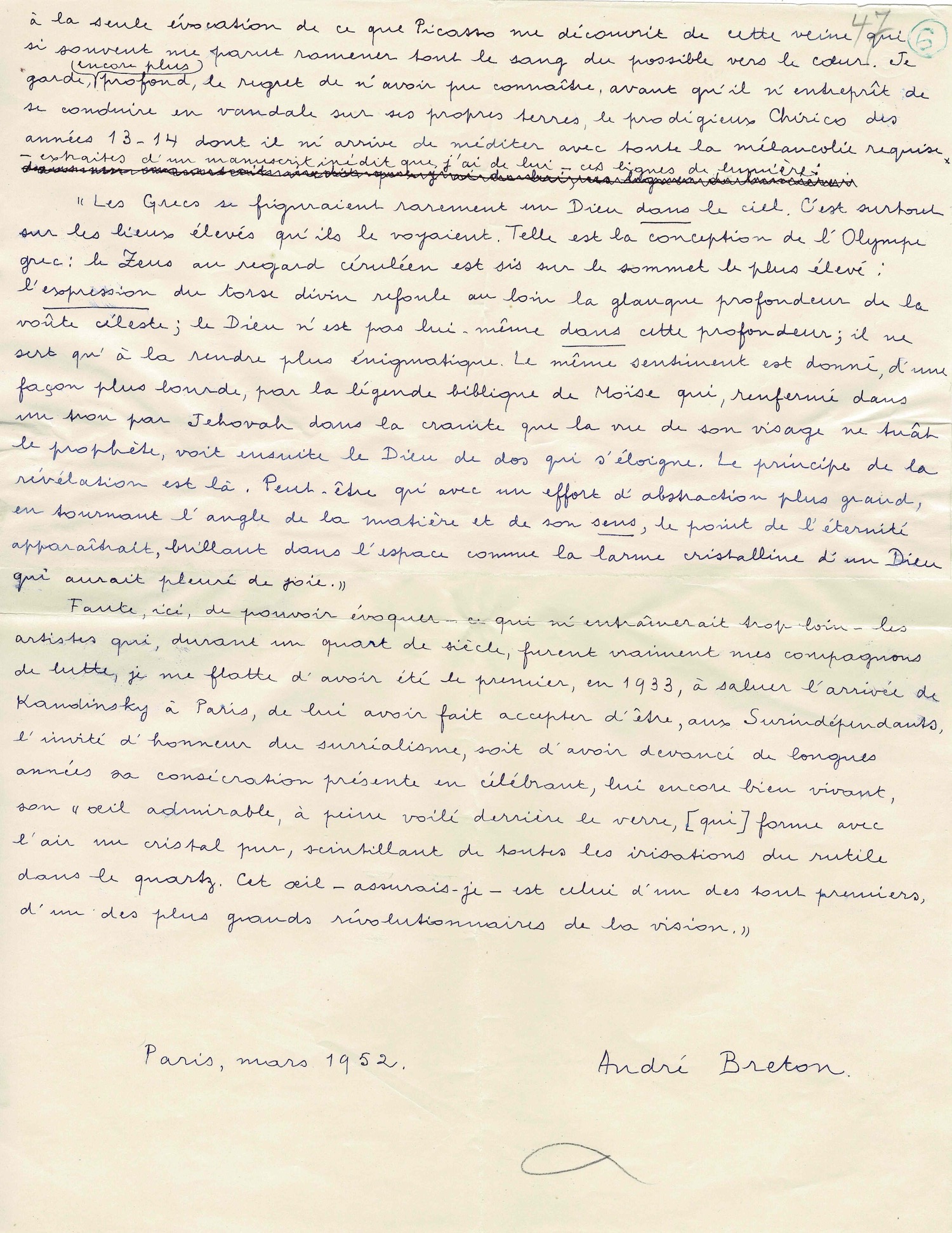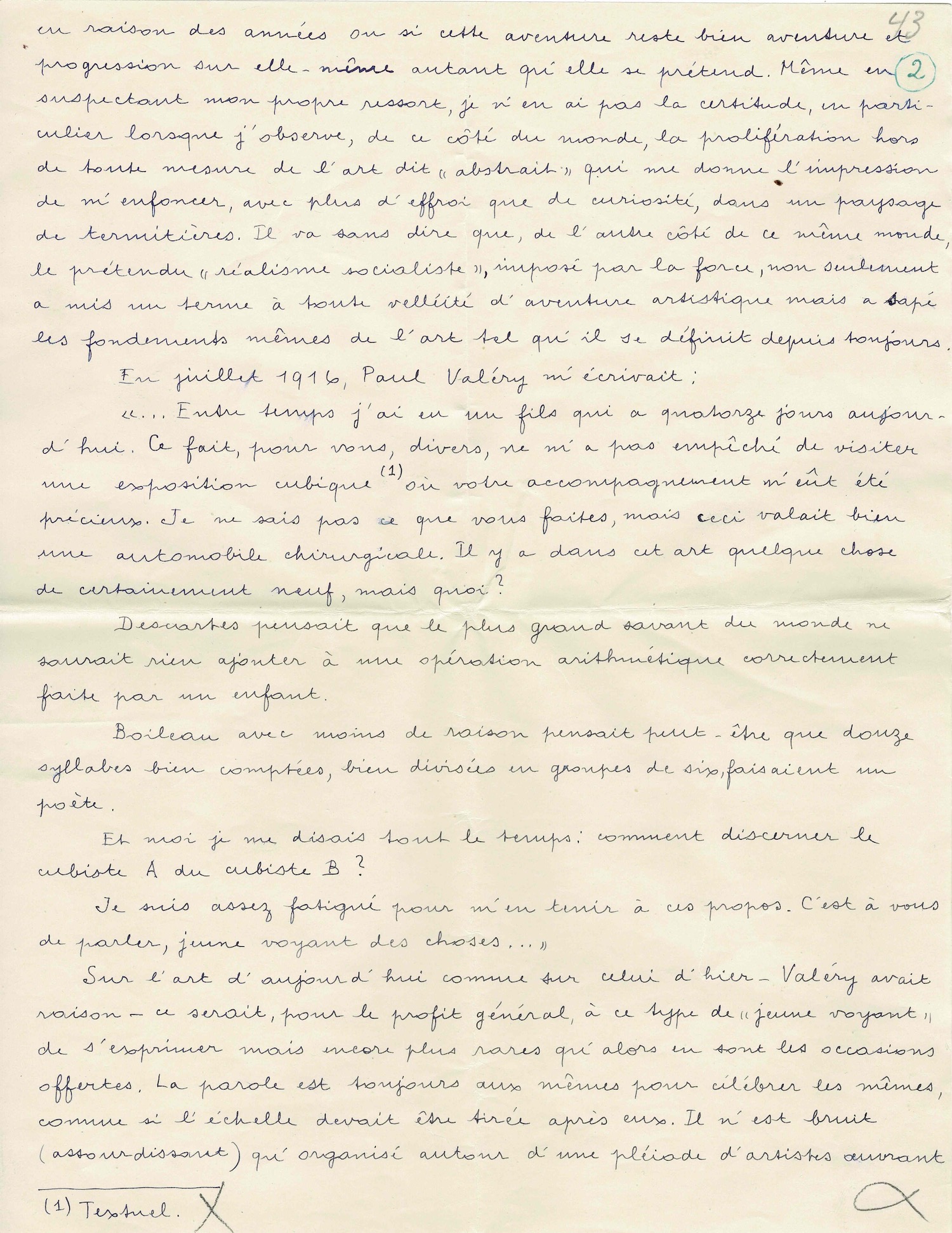André Breton (1896.1966)
Signed autograph manuscript – À L’ŒIL NU
Six pages in-4° on cream paper.
Paris. March 1952.
“I often tell myself that this open eye of youth remains the only good one. »
André Breton analyzes the relationship between men and the beauty of pictorial works. Invoking the modern outlook of youth, he looks back on his first artistic loves, on some masterpieces from his collection and, from Picabia to Picasso, from Braque to Modigliani, on the great masters who influenced and guided him in the quest for Beauty.
This text was published under the title "It's up to you to speak, young seer of things", in the revue XXth century, in June 1952. We attach the seven pages of proofs corrected and signed by Breton.
__________________________________________________________________
WITH THE NAKED EYE
“How could I not keep the eye that I had at seventeen or eighteen years old for such plastic works that were then brand new, facing almost unanimous criticism and intolerance! The encounter with these works, even with mediocre photographic reproductions of them, lifted me, it seems to me, above myself, offered me the most exhilarating glimpse of the possible of which I was unable , naturally, discover only from a distance that he was the certain one . I said a long time ago that I was incapable of considering a painting other than “as a window whose first concern is to know what it looks out ” and one can imagine that I was implying by that: “ In any case, nothing of current appearances. » [ * Rimbaud]. The first condition of pleasure – whether it was felt in light or dark – was that there was a revolution in these appearances, that we were transported outside (as far as possible) from conventional life. I was far from having explored the theories that abounded at the time (it was 1913-1914) and, without any connection with any being in the world who shared my tastes, I did not even know how to defend myself from the accusation of " snobbery.” Since then, critical rationalization has provided me and others with good reasons to love what I loved and what they abominated. I congratulate myself on it without any other transport, like having lived.
Nevertheless, I often tell myself that this open eye of youth (open to what is not yet but which, we obscurely sense, will be) remains the only good one . Not knowing that it is the eye of youth, I was surprised at that time to no longer find it among men who seemed to have had it like Valéry for Renoir, or who certainly had had it like Fénéon for Seurat. Considering what is happening today to the plastic adventure, I sometimes wonder if the declining interest that I have in it is due to an inevitable warping of the outlook due to the years or if this adventure remains an adventure and progression on it. -even as much as she claims to be. Even if I suspect my own motives, I am not certain, particularly when I observe, on this side of the world, the beyond all measure proliferation of so-called “abstract” art which gives me the impression of sinking, with more fear than curiosity, into a landscape of termite mounds. It goes without saying that, on the other side of this same world, the so-called "socialist realism", imposed by force, not only put an end to any desire for artistic adventure but undermined the very foundations of art as it has always been defined.
In July 1916, Paul Valéry wrote to me: “…In the meantime I have had a son who is fourteen days old today. This fact, for you, various people, did not prevent me from visiting a cubic exhibition where your support would have been precious to me. I don't know what you're doing, but this was worth a surgical automobile. There is certainly something new in this art, but what? Descartes believed that the greatest scientist in the world would not be able to add anything to an arithmetic operation correctly performed by a child. Boileau, with less reason, perhaps thought that twelve well-counted syllables, well divided into groups of six, made a poet. And I kept saying to myself: how can I distinguish Cubist A from Cubist B? I'm tired enough to stick to these words. It’s up to you to speak, young seeing things…”
On the art of today as on that of yesterday – Valéry was right – it would be, for the general benefit, for this type of “young clairvoyant” to express himself but even rarer than then are the opportunities offered. The word is always the same to celebrate the same, as if the ladder had to be pulled after them. There is only (deafening) noise organized around a host of artists working for half a century and of whom it would obviously be too much to ask to arouse throughout their lives the interest and emotion which attached themselves, in already distant times, to the most audacious and lofty formulation of their message. At least from the point of view from which I place myself, the attitude towards art should continue to be a quest in all directions and not consist of spying on the slightest gestures of those who were conquerors, when the wind of conquest no longer carries them : their share would still be quite good without that. In the times we live in, it is unfortunate that routine and commercial speculation dictate otherwise. Which sufficiently independent magazine will decide to open an investigation into the most sensitive circles of young people to learn from them the names of the living artists who are truly in their favor and even – because there would be no need to fear, in this area , to make the judgment extremely subjective – what are the five to ten plastic works of today that exert the greatest attraction on each of those we consult? I have no doubt that such an investigation would provide surprises, that it would bring out of the shadows and promote to the rank due to them the artists and works who have for them not yesterday but tomorrow .
Still, if I had had to answer it myself at the time when, having just opened up and somewhat initiated myself into contemporary painting, it was for me the object of a thrilling question, I would hardly have hesitated in my choice. I add that, subsequently, I was able to see that this choice anticipated the recognition of a fairly large number of values.
Some of the works that I would have nominated then? I will name them in the order in which they appeared to me: The Portrait (of his wife) by Matisse, exhibited at the Salon d'Automne of 1913, of which – although I have never seen it since – I cannot forget the crown of black feathers, the thin tawny fur and the emerald blouse (wasn't the hair café au lait?) This for me is a perfect example of the work-event (well beyond even La Joie de vivre and La Danse aux capucines , which I so often went to see again at the old Bernheim gallery on rue Richepanse, where they remained hanging for years).
The Portrait of the Knight “Journal” unfolded that he holds in his hands has long intrigued me, and held me back. By the same artist, on the wall of his studio around 1918, a large Cabaret du front , of which I do not know what has become.
The Brain of the Child , by Chirico, which has not left me since the day when, exhibited on rue la Boétie in the window of the Paul Guillaume gallery, it alerted me to the point of forcing me to get off the bus to examine it at your leisure. Years after I had acquired it, this painting was to return to the same place on the occasion of an exhibition: the fact that, passing by there, also by bus, Yves Tanguy – whom I did not yet know – had the same reflex as me, enough to give objectivity to such an appeal.
The Clarinet Player , by Picasso and also his extraordinary wooden still life constructions (1913-1914) of which it seems that nothing has survived, apart from the very insufficient photographic image. The Woman in a Shirt (1915) also known as “Woman with Golden Breasts”.
Udnie, young American girl , by Picabia.
To which were subsequently added:
The Bride Stripped Bare by Her Bachelors, even , by Duchamp, in which the greatest part of the cycle of the modern legend shines and is fulfilled for me.
The first “collages” by Max Ernst, arriving from Cologne by post, which made some of us stare in wonder all one evening.
Miró's paintings from 1924-25: The Plowed Earth , Catalan Landscape (The Hunter) , Carnival of Harlequins , all together ingenuous, rebellious and so sure of themselves, – crazy with joy.
This is what takes center stage for me, this is what I would like to know what the equivalent is for a young eye today.
I have given in, I will give in again, to a need that I have difficulty explaining, that of “owning” paintings: it could be, quite banally, to be able to caress them with my gaze or change their angle when I please. but rather I believe that it is in the hope of appropriating certain powers which in my eyes electively they hold. Very often it happened to me in the evening to hang this or that painting on the wall, in front of my bed, so that I could experience its seduction on me when I woke up. Thus I was able to ensure that the happiest waves were dispersed to me by the Braque blonds of 1912: it seems to me that the investigation that I suggested should be extended to this morning questioning, which provides information on individual taste a significant clue (in the absence of original works, beautiful color reproductions would allow us to decide if necessary).
As, over the course of life, I have been far from being able to keep all these paintings that I had managed to bring into my home, I distinguish quite well from those which it was not too cruel for me to part with. , those that I have never ceased to regret, even that I find it difficult to forgive myself for having had to give up to another chance than mine. I limit myself to mentioning, among the latter, Melancholy and Mystery of a Street , by Chirico, Woman with a Mandolin , by Picasso and, above all, The Bride by Duchamp.
The relationships, some prolonged, others fleeting, that I maintained with paintings have left a big mark on my life. One of my first poems (1916) is dedicated to André Derain, whose work before the war of 1914 had a long influence on me. I remember the hours spent alone with him in his studio on rue Bonaparte where, between two superb soliloquies on art and medieval thought, he read me the tarot cards. I found this contact, exhilarated from the outset, with Vlaminck to whom, in 1918, I came to ask, on behalf of Apollinaire, where the decorations for Couleur du temps . I still keep in my ear the brilliance of his fantastic stories, borrowed from everyday life, of which he is the first to frighten us. I see myself again, one spring morning in 1919, sitting on a bench on Avenue de l'Observatoire, near Modigliani while discovering the "Poems" of Isidore Ducasse which have just been published in Littérature : no one is quicker to grasp its importance, no one has a more lucid and more enthusiastic first look at this enigmatic work. I recall my frequent visits to the friendly merchant and poet Zborowsky in fear of not being able to follow throughout the plot of Soutine's first landscapes, where the most ardent feeling of nature unleashes itself in sumptuous cashmere. I revive, at the thought of my first encounters with him, the great inner turmoil of Braque, a lyre string strained to break in the woods. To even think of giving a weak account of it, too many impressions, each stronger than the other, assail me at the mere mention of what Picasso discovered for me in this vein which so often seemed to me to bring all the blood of the possible back to the heart. I keep, even more deeply, the regret of not having been able to know, before he undertook to behave like a vandal on his own lands, the prodigious Chirico of the years 13-14 about whom I sometimes meditate with all the required melancholy – extracted from an unpublished manuscript that I have of his – these lines of light:
“The Greeks rarely imagined a God in the sky. It was especially on high places that they saw it. This is the conception of Greek Olympus: Zeus with his cerulean gaze is seated on the highest summit: the expression of the divine torso pushes back into the distance the glaucous depth of the celestial vault; the God is not himself in this depth; it only serves to make it more enigmatic. The same feeling is given, in a heavier way, by the biblical legend of Moses who, confined in a hole by Jehovah in fear that the sight of his face would kill the prophet, then sees the God from behind who distant. The principle of revelation is there. Perhaps with a greater effort of abstraction, by turning the angle of matter and its meaning , the point of eternity would appear, shining in space like the crystalline tear of a God who had cried with joy. »
Failing, here, to be able to evoke – which would take me too far – the artists who, for a quarter of a century, were truly my companions in struggle, I flatter myself that I was the first, in 1933, to salute the arrival of Kandinsky in Paris , to have made him agree to be, at the Surindépendants, the guest of honor of surrealism, or to have anticipated his present consecration by many years by celebrating, he still very much alive, his "admirable eye , barely veiled behind the glass, [which] forms with the air a pure crystal, sparkling with all the iridescence of rutile in quartz. This eye – I assured – is that of one of the very first, of one of the greatest revolutionaries of vision. Paris, March 1952. André Breton. »

